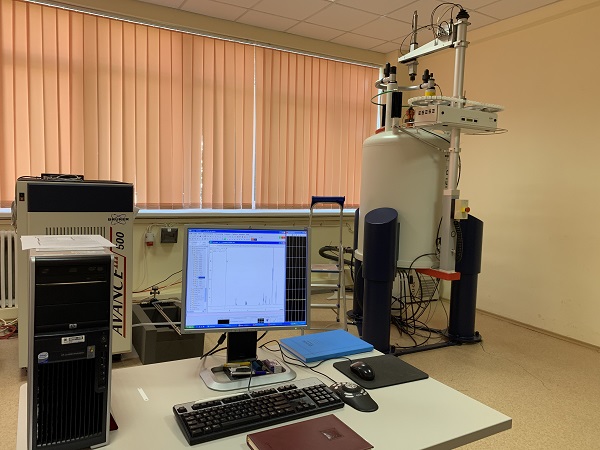Liquid NMR spectroscopy
Researcher: Adrian Pîrnău
Keywords: Nuclear Magnetic Resonance, liquid NMR, structure, intermolecular interactions
Keywords: Nuclear Magnetic Resonance, liquid NMR, structure, intermolecular interactions

Nuclear Magnetic Resonance Spectroscopy on liquid samples is an analytical technique for the characterization of molecular and biomolecular systems with which information about structure, dynamics and intermolecular interactions is obtained.
NMR spectroscopy involves the quantum magnetic properties of atomic nuclei. These properties are influenced by the molecular neighborhood, and their measurement provides a map of interatomic bonds and a description of molecular dynamics.
The nuclei most often studied are 1H, 13C, 15N, 2H, 19F, 31P by 1D measurements. The most commonly used 2D measurements are: COSY, HETCOR, HSQC, HMBC, ROESY.
Fields of application: research and development, optimization of industrial processes / products, quality control (authentication, adulteration, detection of impurities, stability under different environmental conditions, quantitative determinations, etc.)
Systems:
Industries: pharmaceutical industry, food supplements industry, chemical industry, environment / depollution, agro-food industry, health – nanomedicine
The NMR spectroscopy laboratory is equipped with a Bruker Avance III 500 MHz spectrometer dedicated to applications on liquid samples. It consists of a cryo-magnet with the magnetic field produced by the 11.7 Tesla superconducting coil, three radio-frequency channels and is equipped with four sample heads, which cover almost the full range of applications of high-resolution NMR spectroscopy on liquid samples:
INCDTIM offers CDI services based on NMR spectroscopy, used on its own or in combination with other complementary analytical techniques, covering almost the full range of practical applications
Prior to entering into a contractual relationship we provide consultancy to define the client/partner’s needs as accurately as possible and, if required, we carry out preliminary tests free of charge
Existing facilities allow us to address most of the MRI methods used in current practice, many of which are already implemented in our laboratory
We have staff able to cover with the highest professionalism all the stages of a contractual collaboration: definition of the problem to be solved, experimental design, data collection, interpretation of the results and their correlation with other complementary information, if necessary
The total cost of CDI services based on NMR spectroscopy consists of two components:
spectrometer usage time, which includes consumables and wear and tear: 50 lei/hour
labor, which includes personnel and indirect costs associated with sample preparation operations, analysis and interpretation of results, preparation of the analysis/research report: negotiable, depending on the complexity of the study.